Buddhist Values of Thailand Taught a Seattle Woman
To Help People of Earthquake-Ravaged Nepal
Written by: Susan Alotrico

Susan Alotrico leading Nepali children in uplifting activity.
Photos by: Susan Alotrico
A year after the massive earthquake in Nepal, just after returning to Seattle from a three-year stint in Peace Corps, I find myself in a position to help.
Global Peace Foundation, headquartered in Maryland, has asked me to serve as a volunteer senior advisor. My work will be to bring together West Coast volunteers, and funds, to support the foundation’s relief work in Nepal.
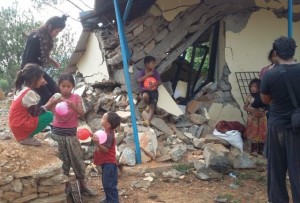
The earthquake damaged schools in Nepal, such as this one in Nuwakot.
Sustainable development skills are especially needed to help Nepali youth rebuild their country after the earthquake. The foundation also wants to help Nepali women with education and income-generation skills, so they can support themselves and their families over time.
Working on relief efforts in Nepal is not what I expected my homecoming to Seattle would be, where I practice the Buddha’s dharma with Seattle Insight Meditation Society.
This work of extending beyond oneself is called karuna work, or compassion work. The heart just opens, trusts the truth of connection, awakens to compassion, and takes action.
The immediate impacts of the 2015 Nepali earthquake were only the beginning. Compounding the suffering were a new constitution, deadly fighting, a fuel embargo from India, and winter. All diverted attention and hampered delivery of humanitarian aid to the most vulnerable.
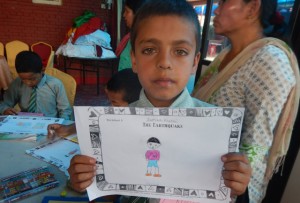
Young boy holds his drawing of the day of the earthquake.
More than 2 million people were displaced and now live in temporary shelters, many in mountainous areas where survival necessities are sparse. Meanwhile, thousands of students go to school in makeshift tents.
I had never planned to be doing relief work for Nepal. But I had earlier met a group of Nepali youth at a United Nations summit on global youth volunteerism in Bangkok, while I was serving in the Peace Corps in Thailand, and those young people provided a link I could not ignore.
I had planned a trip to Bhutan and Nepal after my three-year Peace Corps stint, and went to Bhutan first. The earthquake hit when I was in Bhutan, exploring its wild beauty of smoky forests filled with jewel-red, rhododendron trees, mixed with a supernatural, Buddhist-infused culture.
A call from Nepal
Suddenly, following the earthquake, all my trajectories changed. I had stayed in touch with my young Nepali friends via Facebook and so I contacted them.
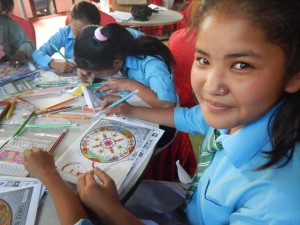
Student colors a mandala of strength at healing arts camp.
They told me about the needs there, and canceling my planned trip Nepal just didn’t feel right. So I left Bhutan for Nepal less than one week later, to work and live with these Nepali youth over the next four months.
I questioned going into an earthquake zone and so did some of my friends and family. A friend on Facebook put it this way: “Maybe it’s time for you to come home, they’ve just had a major earthquake, just sayin’.”
But my dad wrote, “I’m proud of you…. I hope you’ll know when your time is up.”
I never felt as right as I did going to Nepal. I made the decision with both feet solidly planted on the earth. There was ease in the decision, no fear. Was this an outgrowth of my meditation practice? My Peace Corps experience? Both? I just didn’t feel separate from anyone. I simply felt among them, together.
Luckily, the one-story house/office in Katmandu, which often housed six staff and volunteers, had withstood the earthquakes and kept everyone safe.
My heart wrenched as I listened to people’s stories.

Healing Arts Nepal team takes an impromptu selfie. Front left to right, Ganesh Amgain, Manju Dulal, Binod Joshi, Susan Alotrico, Ram Pukar Mohara, and Sandhya Acharya.
A man I would soon work closely with, told of having to run out of his house with his family, his father in his arms, his house crumbling behind them. The next day his father died.
A Tibetan monk grieved in the post office, as he told me of people who died at his monastery.
I could only listen to his story through his tears. Holding the sadness of people through presence and deep listening showed me how just being was enough. There was also an urgency to do whatever I could to help.
Within a week of my arrival, a group of Nepali stakeholders convened to review a proposal to develop and implement a healing arts program aimed at building strength and resiliency in children impacted by the earthquake. The idea drew support from psychologists, psychology students from Tribuvan University in Kathmandu, and from volunteers and staff at several relief organizations.
We worked hard, and just 12 days later presented a two-day training program called Healing Arts Nepal, which attracted 81 people to learn how to conduct workshops for people who had been traumatized by the earthquake. Together the participants learned new teaching skills, and to practice fun and healing activities.
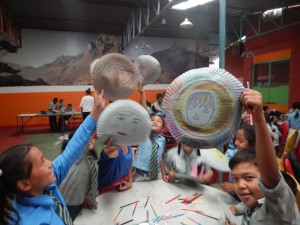
Students hold emotion masks at Healing Arts Nepal camp.
We provided all those participating with a facilitator guide, and reproducible student worksheets, so they could adapt and lead the program within their own organizations or schools.
Over the next eight weeks more the 600 earthquake-impacted people were reached through these workshops.
About 300 of those were children, who participated in healing arts activities including a one-day, healing arts camp for students. The camps provided guided activities in a safe place to explore emotions, loss and qualities of inner strength, and to build resiliency through expression of the creative arts.
We adapted the Healing Arts Nepal program from Art with Heart, a Seattle-based non-profit that helps children overcome trauma through creative expression. I had seen the Art with Heart in action in a former job, and knew of its transformational quality.
Art with Heart donated 200 therapeutic workbooks for Nepali children, a value of $1,500.
The kind embrace of Thai people
Perhaps I can trace some of my activity to Buddhist values I learned during my three years in the Peace Corps in rural north Thailand.
Living there, I let go of everything I thought things and people should be, and was taken to new levels of love, trust, compassion and generosity.
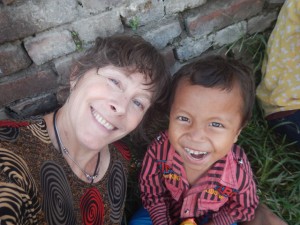
Susan Alotrico with Rawi, a young boy recovering from the earthquake.
Friendship and connection met me anytime I allowed. I learned generosity from people who lived with Buddhism infused in the bones of their language and culture. For instance “Naam jai” in Thai, translated as “water heart,” means generosity.
While riding my Peace Corps-issue mountain bike, I would wave and smile. The most common greeting is “gen kao roo yang?” Have you eaten yet? Many people would stop to give me a papaya or bananas.
Thais eat outside often because it is so hot. I would pass people eating and they would wave me in. I would stop out of respect, even though I sometimes wasn’t hungry. You are not an individual in Thailand, you are a community.
I was always stepping outside my comfort zone and into the moment. My Peace Corps experience gave me the courage to go to Nepal because I understood that connection happens in the heart, regardless of culture or language.
I have a deeper commitment to meditation practice today. I don’t know when I am going back to Asia, but as I adapt to life in the America, and I as I continue to help the people of Nepal, I feel lucky to have my dharma community to guide me along.
If you wish to explore community-based approaches and sustainable solutions for development in Nepal, please email me at alotricosb52@gmail.com.
